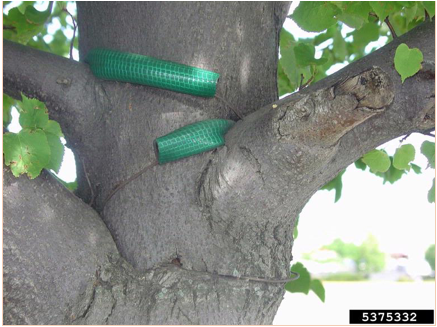March 24, 2018
Mis-staking with Good Intentions
Question:
Should I stake the new trees I plant this spring? I heard staking can be bad, but we have a very windy yard.
- Matt C., Clovis, NM
Answer:
You heard right. Staking trees can be bad. You are also right that the spring winds in New Mexico can be extremely strong. The Albuquerque National Weather Service tweeted the high wind reports from March 18, with Curry County in the lead for highest wind speed on that day at 73 mph at Cannon AFB (@NWSAlbuquerque). Sustained winds of 74 mph define the lower speed limit for a category 1 hurricane. #nmtrue
Staking a newly planted tree may seem like a kind thing to do for a new friend. The reality is that staked trees tend to generate weaker roots after planting, compared with un-staked trees. Trunk movement, like that caused by spring winds, actually increases the strength of tree wood and the size of the root system. According to the International Society of Arboriculture’s newest planting standards, research has shown that un-staked trees become established more quickly and with sturdier trunks and roots than staked trees. Along with reduced root development, staked trees tend to be taller and have thinner trunks than un-staked trees, which results in a higher tendency for trunk breakage once staking is removed. If you buy a tree that was staked in the nursery, go ahead and remove that stake along with all of the ties when you plant.
There are some circumstances where staking might be necessary, but even then there are specific guidelines to follow for minimal tree injury. Instead of one stake doing all the work, two or three stakes, each with separate ties and positioned strategically for wind direction, will be less damaging. The ties need to be attached as low as possible on the young trunk, no higher than 2/3 the height of the tree so that the canopy can still move freely. The wider and more flexible the tie material the better, to avoid cutting into or rubbing the young bark tissue. Never stake so tightly that zero trunk movement is allowed. After the stakes and ties are in place, wiggle the trunk to be sure the tree will get at least some of the benefits of increased vigor that come with natural development. Always remove all staking materials within the first year of planting! Even material that you think is loose or stretchy can kill a tree if left on long enough to wound the trunk and cause girdling (Fig. 1).

Some fruit trees are sold with dwarfing rootstocks, which are recommended due to improved quantity and quality of fruit, plus less pruning maintenance, and all kinds of other advantages. However, in order to maintain a small size, dwarfing rootstocks may have reduced rooting speed and total area, so they may need staking in that first year more than other trees.
According to Dr. Linda Chalker-Scott, Extension Urban Horticulturist at Washington State University, the three cardinal sins of tree staking are staking too high, staking too tightly, and staking too long.
Generally, trees that grow well in New Mexico can stand our winds. I recommend planting without stakes to start and keeping an eye out during this first spring for signs of leaning. Leaning may indicate other adverse growing conditions, like compacted soils, a root ball that’s too tight and needs to be loosened, or overwatering. If you decide to stake during the windy season, be sure to remove all stakes and ties – the sooner the better.
Spring started this week, and we’re so excited we wet our plants. If your garden is budding out too, and you haven’t irrigated recently, this is a good time for a slow soak. Depending on the size of the tree, shrub, vine, perennial, or annual plant, aim for a watering depth of 3 feet for the larger trees down to 1 foot for smaller specimens. That may mean getting out there mid-watering with a spade to check moisture depth in a few spots.
Marisa Y. Thompson, PhD, is the Extension Horticulture Specialist, in the Department of Extension Plant Sciences at the New Mexico State University Los Lunas Agricultural Science Center, email: desertblooms@nmsu.edu, office: 505-865-7340, ext. 113.
Links:
For more gardening information, visit the NMSU Extension Horticulture page at Desert Blooms and the NMSU Horticulture Publications page.
Send gardening questions to Southwest Yard and Garden - Attn: Dr. Marisa Thompson at desertblooms@nmsu.edu, or at the Desert Blooms Facebook page.
Please copy your County Extension Agent and indicate your county of residence when you submit your question!